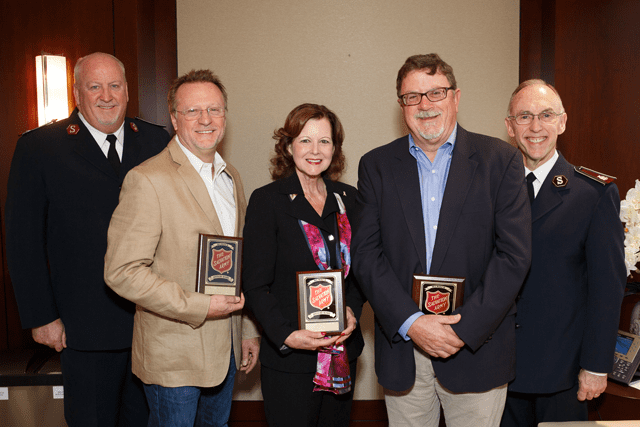Listen to this article
Listen to this article
Loading
Play
Pause
Options
0:00
-:--
1x
Playback Speed- 0.5
- 0.6
- 0.7
- 0.8
- 0.9
- 1
- 1.1
- 1.2
- 1.3
- 1.5
- 2
Audio Language
- English
- French
- German
- Italian
- Spanish
Open text
western social services councils 2013. delegates discuss a vision to share and galvanize. by christopher doughty. more than 80 delegates from around the western territory flocked to redondo beach, calif., in mid-september for the biannual western social services councils (wssc) to discuss a range of social service issues and promote new territorial social service initiatives. comprised of eight united sessions and 31 workshops over the course of three days, the conference offered participants the opportunity to earn certificates in one of five areas of specialization: missionbridge chaplaincy, human anti-trafficking, pathway of hope new corps case management tools, social service basic finance and business, and social service research. the territorial social services department aimed to encourage stronger salvation army engagement in social services research. dr. peter lee, a professor at san jose state university school of social work and member of the conference planning team, said members of the salvation army at all levels can contribute to such a testimonial knowledge base. “we embrace the army’s promise of ‘doing the most good,’” lee said. “we do want to celebrate our passion in terms of serving others while being rooted in god’s love. but do we actually consider what it means to ‘do the most good’? what does that mean? and how do we know whether we’re doing the good, best—the goodest?”. presenters noted the information is useful not only for appeals to grant providers, but for the well-being of the people and communities served, as well as the army’s public reputation. “the salvation army is in every zip code in america,” said major darryl leedom, national social services secretary. “we are a garment of compassion that covers the entire nation, but all of this service also brings a responsibility…when we are privileged to come alongside [the vulnerable and the poor], we also have a responsibility to tell their story.”. the conference also served as a launchpad for two new territorial initiatives: missionbridge and pathway of hope. presenters keyed in on tackling the underlying issues of those who seek the salvation army’s assistance, instead of simply addressing their surface needs. “the opposite of poverty is not wealth; the opposite of poverty is sufficiency,” leedom said. “are we creating a mechanism to alleviate poverty, to stop this generational poverty scheme that holds people prisoner?”. pathway of hope is the salvation army’s answer, providing comprehensive case management for families who receive services through corps social service programs. after three years of development and a year of implementation in the central territory, the western territory selected two pilot divisions to gauge its viability in the west. missionbridge is designed to connect designated social service programs and corps ministries through existing salvationists trained as missionbridge chaplains. “it’s kind of a takeoff from church planting, but we’re using something we already have,” said major lawrence shiroma, territorial social services secretary. “duality of purpose—spiritual and social redemption.”. dr. robert docter, long-time salvationist and professor emeritus at california state university, northridge, echoed these sentiments in a keynote address on the future of social services. “a generation ago,” he said, “the social work ministry fed the corps. it needs to do that now.”. the occasion also recognized the recipient of the western territory social services award for excellence in social work—linda rich, executive director of family treatment services (fts) in hawaii. rich began as fts clinical director in 1992 and has served as executive director for the past seven years. under her leadership, fts has consistently earned high marks from the national commission on accreditation of rehabilitation facilities for its exceptional mental health and substance abuse treatment services.
Open context player
Close context player
Plays:-Audio plays count
western social services councils 2013. delegates discuss a vision to share and galvanize. by christopher doughty. more than 80 delegates from around the western territory flocked to redondo beach, calif., in mid-september for the biannual western social services councils (wssc) to discuss a range of social service issues and promote new territorial social service initiatives. comprised of eight united sessions and 31 workshops over the course of three days, the conference offered participants the opportunity to earn certificates in one of five areas of specialization: missionbridge chaplaincy, human anti-trafficking, pathway of hope new corps case management tools, social service basic finance and business, and social service research. the territorial social services department aimed to encourage stronger salvation army engagement in social services research. dr. peter lee, a professor at san jose state university school of social work and member of the conference planning team, said members of the salvation army at all levels can contribute to such a testimonial knowledge base. “we embrace the army’s promise of ‘doing the most good,’” lee said. “we do want to celebrate our passion in terms of serving others while being rooted in god’s love. but do we actually consider what it means to ‘do the most good’? what does that mean? and how do we know whether we’re doing the good, best—the goodest?”. presenters noted the information is useful not only for appeals to grant providers, but for the well-being of the people and communities served, as well as the army’s public reputation. “the salvation army is in every zip code in america,” said major darryl leedom, national social services secretary. “we are a garment of compassion that covers the entire nation, but all of this service also brings a responsibility…when we are privileged to come alongside [the vulnerable and the poor], we also have a responsibility to tell their story.”. the conference also served as a launchpad for two new territorial initiatives: missionbridge and pathway of hope. presenters keyed in on tackling the underlying issues of those who seek the salvation army’s assistance, instead of simply addressing their surface needs. “the opposite of poverty is not wealth; the opposite of poverty is sufficiency,” leedom said. “are we creating a mechanism to alleviate poverty, to stop this generational poverty scheme that holds people prisoner?”. pathway of hope is the salvation army’s answer, providing comprehensive case management for families who receive services through corps social service programs. after three years of development and a year of implementation in the central territory, the western territory selected two pilot divisions to gauge its viability in the west. missionbridge is designed to connect designated social service programs and corps ministries through existing salvationists trained as missionbridge chaplains. “it’s kind of a takeoff from church planting, but we’re using something we already have,” said major lawrence shiroma, territorial social services secretary. “duality of purpose—spiritual and social redemption.”. dr. robert docter, long-time salvationist and professor emeritus at california state university, northridge, echoed these sentiments in a keynote address on the future of social services. “a generation ago,” he said, “the social work ministry fed the corps. it needs to do that now.”. the occasion also recognized the recipient of the western territory social services award for excellence in social work—linda rich, executive director of family treatment services (fts) in hawaii. rich began as fts clinical director in 1992 and has served as executive director for the past seven years. under her leadership, fts has consistently earned high marks from the national commission on accreditation of rehabilitation facilities for its exceptional mental health and substance abuse treatment services.
Listen to this article













